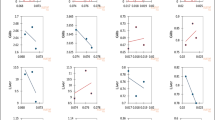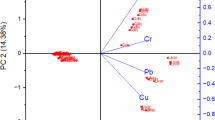Abstract
Fish feed quality is the main determinant of fish flesh quality, so it is important for successful aquaculture. The current study determines the concentration of heavy metals in fish feeds (A and B), water, and their bioaccumulation in gills, liver, and muscle of C. carpio cultured in different environments (biofloc technology and earthen pond systems). In addition, the correlation between heavy metals in fish feeds with bioaccumulated metals in fish tissues was also determined. Results revealed that most heavy metal concentration was significantly greater (P < 0.05) in feed B than in feed A but in permissible range, while all the heavy metal concentration was notably higher in earthen ponds than in biofloc technology. Result from the bioaccumulation factor and concentration of the metals showed that heavy metals were highly accumulated in the fish liver followed by gills. The metal concentration in fish feeds and fish edible parts (muscle) was lower than the WHO standard level; however, the amount of Pb was higher in the fish muscle, liver, and gills, which is harmful for human consumption and also for fish health. Though the correlation test revealed that all of the metals from the feeds were positively correlated to the metals in fish tissues, but most of the estimated correlation was significant and linearly correlated. It can be concluded that producers must measure feed quality correctly to avoid heavy metal contamination because it may assimilate and accumulate in the food chain.




Similar content being viewed by others
Data Availability
During present study, all the generated datasets and analyzed data are available from the corresponding author on reasonable request.
References
Ihedioha JN, Ukoha PO, Ekere NR (2017) Ecological and human health risk assessment of heavy metal contamination in soil of a municipal solid waste dump in Uyo, Nigeria. Environ Geochem Health 39(3):497–515
Oyetibo GO, Miyauchi K, Huang Y, Chien MF, Ilori MO, Amund OO, Endo G (2017) Biotechnological remedies for the estuarine environment polluted with heavy metals and persistent organic pollutants. Int Biodeterior Biodegrad 119:614–625
Oyugi AM, Kibet JK, Adongo JO (2021) A review of the health implications of heavy metals and pesticide residues on khat users. Bull Natl Res Cent 45(1):1–22
Dahiya V (2022) Heavy metal toxicity of drinking water: a silent killer. GSC Biol Pharm Sci 19(1):020–025
Peccerillo A (2021) The geochemical cycles and the environment—how man is changing the earth. In: Air, Water, Earth, Fire. Springer, Cham, pp 153–181
Al Naggar Y, Khalil MS, Ghorab MA (2018) Environmental pollution by heavy metals in the aquatic ecosystems of Egypt. Open Acc J Toxicol 3:555603
Fazio F, Habib SS, Naz S, Ullah M, Nawaz G, Nava V, Piccione G, Arfuso F (2022) Withania coagulans fruit extract: a possible useful additive in ameliorating growth and immunity of Labeo rohita (Hamilton, 1822). Nat Prod Res:1–6. https://doi.org/10.1080/14786419.2022.2089139
Łuczyńska J, Paszczyk B, Łuczyński MJ (2018) Fish as a bioindicator of heavy metals pollution in aquatic ecosystem of Pluszne Lake, Poland, and risk assessment for consumer’s health. Ecotoxicol Environ Saf 153:60–67
Obiero K, Meulenbroek P, Drexler S, Dagne A, Akoll P, Odong R, Kaunda-Arara B, Waidbacher H (2019) The contribution of fish to food and nutrition security in Eastern Africa: Emerging trends and future outlooks. Sustainability 11(6):1636
Hembrom S, Singh B, Gupta SK, Nema AK (2020) A comprehensive evaluation of heavy metal contamination in foodstuff and associated human health risk: a global perspective. In: Contemporary environmental issues and challenges in era of climate change. Springer, Singapore, pp 33–63
Fazio F, Habib SS, Naz S, Hashmi MA, Saoca C (1839) Ullah M (2022) Cadmium sub-lethal concentration effect on growth, haematological and biochemical parameters of Mystus seenghala (Sykes. Biol Trace Elem Res 200(5):2432–2438
Sarkar MM, Rohani MF, Hossain MAR, Shahjahan M (2022) Evaluation of heavy metal contamination in some selected commercial fish feeds used in Bangladesh. Biol Trace Elem Res 200(2):844–854
Korish MA, Attia YA (2020) Evaluation of heavy metal content in feed, litter, meat, meat products, liver, and table eggs of chickens. Animals 10(4):727
Fazio F, Habib SS, Naz S, Filiciotto F, Cicero N, Rehman HU, Saddozai S, Rind KH, Rind NA, Shar AH (2022) Effect of fortified feed with olive leaves extract on the haematological and biochemical parameters of Oreochromis niloticus (Nile tilapia). Nat Prod Res 36(6):1575–1580
Habib SS, Batool AI, Rehman MF, Naz S (2022) Evaluation and association of heavy metals in commonly used fish feed with metals concentration in some tissues of O. niloticus cultured in biofloc technology and earthen pond system. Biol Trace Elem Res:1–11. https://doi.org/10.1007/s12011-022-03379-0.
AOAC (2000) Official methods of analysis, 17th edn. Association of Official Analytical Chemists, Gaithersburg
Atta A, Voegborlo RB, Agorku ES (2012) Total mercury distribution in different tissues of six species of freshwater fish from the Kpong hydroelectric reservoir in Ghana. Environ Monit Assess 184(5):3259–3265
Jayaprakash M, Kumar RS, Giridharan L, Sujitha SB, Sarkar SK, Jonathan MP (2015) Bioaccumulation of metals in fish species from water and sediments in macrotidal Ennore creek, Chennai, SE coast of India: a metropolitan city effect. Ecotoxicol Environ Saf 120:243–255
Ali H, Khan E (2018) Bioaccumulation of non-essential hazardous heavy metals and metalloids in freshwater fish. Risk to human health. Environ Chem Lett 16(3):903–917
Men B, He Y, Yang X, Meng J, Liu F, Wang D (2016) Bioturbation effects on heavy metals fluxes from sediment treated with activated carbon. Environ Sci Pollut Res Int 23(9):9114–9121
Has-Schön E, Bogut I, Kralik G, Bogut S, Horvatić J, Čačić I (2008) Heavy metal concentration in fish tissues inhabiting waters of “Busko Blato” reservoir (Bosnia and Herzegovina). Environ Monit Assess 144(1–3):15–22
Gyimah E, Akoto O, Mensah JK, Bortey-Sam N (2018) Bioaccumulation factors and multivariate analysis of heavy metals of three edible fish species from the Barekese reservoir in Kumasi, Ghana. Environ Monit Assess 190(9):1–9
Jaishankar M, Tseten T, Anbalagan N, Mathew BB, Beeregowda KN (2014) Toxicity, mechanism and health effects of some heavy metals. Interdiscip Toxicol 7(2):60
Fu Z, Xi S (2020) The effects of heavy metals on human metabolism. Toxicol Mech Methods 30(3):167–176
Ge D, Zhang L, Long Z, Chi C, Liu H (2020) A novel biomarker for marine environmental pollution: a metallothionein from Mytilus coruscus. Aquac Rep 17:100364
Flores-Lopes F, Correia MA, da Silva DM (2020) Histological and ultrastructural analysis of Tilapia rendalli liver as an environmental assessment tool for Cachoeira River, Bahia, Brazil. Int J Zool Invest 6(1):31–48
Bawuro AA, Voegborlo RB, Adimado AA (2018) Bioaccumulation of heavy metals in some tissues of fish in Lake Geriyo, Adamawa State, Nigeria. J Environ Health 2018:7. https://doi.org/10.1155/2018/1854892
Gu YG, Wang XN, Wang ZH, Huang HH, Gong XY (2022) Metal biological enrichment capacities, distribution patterns, and health risk implications in sea bass (Lateolabrax japonicus). Biol Trace Elem Res:1–10. https://doi.org/10.1007/s12011-022-03255-x
Rajeshkumar S, Li X (2018) Bioaccumulation of heavy metals in fish species from the Meiliang Bay, Taihu Lake, China. Toxicol Rep 5:288–295
Hilal AA, Ismail NS (2008) Heavy metals in eleven common species of fish from the Gulf of Aqaba, Red Sea. Jordan J Biol Sci 1(1):13–18
Resma NS, Meaze AM, Hossain S, Khandaker MU, Kamal M, Deb N (2020) The presence of toxic metals in popular farmed fish species and estimation of health risks through their consumption. Phys Open 5:100052
Roy D, Rahman F, Islam SS, Sarker S, Begum Quraishi S, Hosen MM (2022) Bioaccumulation of heavy metal in urban pond reared Oreochromis niloticus, water, sediment, and handmade feed in Bangladesh and human health risk implications. Arab J Geosci 15(10):1–15
Anhwange BA, Asemave K, Kim BC, Nyiaatagher DT (2012) Heavy metals contents of some synthetic fish feeds found within Makurdi metropolis. Int J Food Nutr Saf 2(2):55–61
Ogello EO, Musa SM, Aura CM, Abwao JO, Munguti JM (2014) An appraisal of the feasibility of tilapia production in ponds using biofloc technology: a review. Int J Aquat Sci 1:21–39
Delahaut V, Rašković B, Salvado MS, Bervoets L, Blust R, De Boeck G (2020) Toxicity and bioaccumulation of Cadmium, Copper and Zinc in a direct comparison at equitoxic concentrations in common carp (Cyprinus carpio) juveniles. PLoS ONE 15(4):e0220485
Vajargah FM, MohamadiYalsuyi A, Hedayati A, Faggio C (2018) Histopathological lesions and toxicity in common carp (Cyprinus carpio L. 1758) induced by copper nanoparticles. Microsc Res Tech 81(7):724–729
WHO (1995) Heavy metals environmental aspects, Tech. Rep., Environmental Health criteria No. 85, Geneva, Switzerland
WHO/FAO (1990) Food standards programme, Guideline levels for cadmium and lead in food. Codex committee of food additives and contamination, 22nd session, Haugue, the Netherlands
Okorie OE, Bae JY, Lee JH, Lee S, Park GH, Mohseni M, Bai SC (2014) Effects of different dietary cadmium levels on growth and tissue cadmium content in juvenile parrotfish, Oplegnathus fasciatus. Asian Australas J Anim Sci 27(1):62
Okocha RC, Adedeji OB (2011) Overview of cadmium toxicity in fish. J Appl Sci Res 7(7):1195–1207
Yi YJ, Zhang SH (2012) Heavy metal (Cd, Cr, Cu, Hg, Pb, Zn) concentrations in seven fish species in relation to fish size and location along the Yangtze River. Environ Sci Pollut Res 19(9):3989–3996
Lin S, Lin X, Yang Y, Li F, Luo L (2013) Comparison of chelated zinc and zinc sulfate as zinc sources for growth and immune response of shrimp (Litopenaeus vannamei). Aquaculture 406:79–84
Chen TH, Lin CC, Meng PJ (2014) Zinc oxide nanoparticles alter hatching and larval locomotor activity in zebrafish (Danio rerio). J Hazard Mater 277:134–140
Öner M, Atli G, Canli M (2008) Changes in serum biochemical parameters of freshwater fish Oreochromis niloticus following prolonged metal (Ag, Cd, Cr, Cu, Zn) exposures. Environ Toxicol Chem 27:360–366
Ekpo KE, Asia IO, Amayo KO, Jegede DA (2008) Determination of lead, cadmium and mercury in surrounding water and organs of some species of fish from Ikpoba river in Benin city, Nigeria. Int J Phys Sci 3(11):289–292
Zeinali T, Salmani F, Naseri K (2019) Dietary intake of cadmium, chromium, copper, nickel, and lead through the consumption of meat, liver, and kidney and assessment of human health risk in Birjand, Southeast of Iran. Biol Trace Elem Res 191(2):338–347
Suchana SA, Ahmed MS, Islam SM, Rahman ML, Rohani MF, Ferdusi T, Ahmmad AK, Fatema MK, Badruzzaman M, Shahjahan M (2021) Chromium exposure causes structural aberrations of erythrocytes, gills, liver, kidney, and genetic damage in striped catfish Pangasianodon hypophthalmus. Biol Trace Elem Res 199(10):3869–3885
Peralta-Videa JR, Lopez ML, Narayan M, Saupe G, Gardea-Torresdey J (2009) The biochemistry of environmental heavy metal uptake by plants: implications for the food chain. Int J Biochem Cell Biol 41(8–9):1665–2167
Author information
Authors and Affiliations
Contributions
Syed Sikandar Habib: conceptualization, writing, methodology, sampling, original draft. Aima Iram Batool: proofreading, supervision. Muhammad Fayyaz Ur Rehman: resources, supervision, proofreading. Saira Naz: data analysis, methodology, proofreading.
Corresponding author
Ethics declarations
Ethics Approval
The authors followed all the valid national rules for the use and care of animals.
Consent for Publication
All authors consented to the publication.
Competing Interests
The authors declare no competing interests.
Additional information
Publisher's Note
Springer Nature remains neutral with regard to jurisdictional claims in published maps and institutional affiliations.
Rights and permissions
Springer Nature or its licensor holds exclusive rights to this article under a publishing agreement with the author(s) or other rightsholder(s); author self-archiving of the accepted manuscript version of this article is solely governed by the terms of such publishing agreement and applicable law.
About this article
Cite this article
Habib, S.S., Batool, A.I., Rehman, M.F.U. et al. Assessment and Bioaccumulation of Heavy Metals in Fish Feeds, Water, and Some Tissues of Cyprinus carpio Cultured in Different Environments (Biofloc Technology and Earthen Pond System). Biol Trace Elem Res 201, 3474–3486 (2023). https://doi.org/10.1007/s12011-022-03415-z
Received:
Accepted:
Published:
Issue Date:
DOI: https://doi.org/10.1007/s12011-022-03415-z




